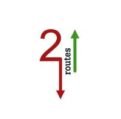Leverage in forex trading is like using a magnifying glass for your money. It allows you to control a larger position in a currency pair with a relatively small deposit of your own capital. Here’s how it works:
- Borrowing to trade: Forex brokers offer leverage, which essentially means borrowing money from them to increase your trading power. This borrowed money is called margin.
- Leverage ratio: Leverage is expressed as a ratio, like 50:1 or 100:1. For example, with a 50:1 leverage, a $1,000 deposit would allow you to control a position worth $50,000.
- Double-edged sword: Leverage can be a powerful tool for amplifying profits if the market moves in your favor. However, it can also magnify losses significantly if the market goes against you.
Here are some key things to remember about leverage in forex:
- Risk management is crucial: Since leverage can magnify losses, forex traders using leverage need strong risk management strategies like stop-loss orders to limit potential losses.
- Margin requirements: Brokers require a certain percentage of the trade value as a deposit, which is the margin. This percentage varies depending on the leverage offered. Higher leverage usually means a lower margin requirement (and vice versa).
- Not for everyone: Leverage can be risky, so it’s generally not recommended for beginner traders. It’s advisable to understand the forex market and risk management techniques before using leverage.
If you’re considering forex trading with leverage, it’s essential to thoroughly research the risks involved and ensure you have a solid understanding of how it works.
